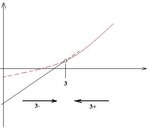eng_boody
Member level 3

pls i'd like to ask how to test for differentiability of a function, what is that related to one sided derivative in case of piece wise defined functions and in lim h->0+ or lim h->0- what does the positive and negative sign beside the zero indicate GRAPHICALLY .. thanks

